
Morningside Heights is a neighborhood on the West Side of Upper Manhattan in New York City. It is bounded by Morningside Drive to the east, 125th Street to the north, 110th Street to the south, and Riverside Drive to the west. Morningside Heights borders Central Harlem and Morningside Park to the east, Manhattanville to the north, the Manhattan Valley section of the Upper West Side to the south, and Riverside Park to the west. Broadway is the neighborhood's main thoroughfare, running north–south.

The New York City Housing Authority (NYCHA) is a public development corporation which provides public housing in New York City, and is the largest public housing authority in North America. Created in 1934 as the first agency of its kind in the United States, it aims to provide decent, affordable housing for low- and moderate-income New Yorkers throughout the five boroughs of New York City. NYCHA also administers a citywide Section 8 Leased Housing Program in rental apartments. NYCHA developments include single and double family houses, apartment units, singular floors, and shared small building units, and commonly have large income disparities with their respective surrounding neighborhood or community. These developments, particularly those including large-scale apartment buildings, are often referred to in popular culture as "projects."
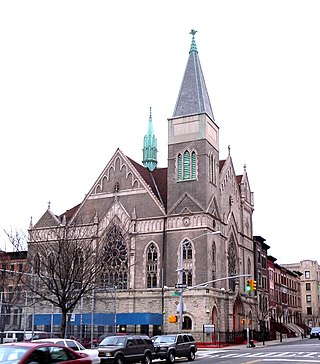
Hamilton Heights is a neighborhood in the northern part of Manhattan in New York City. It is the northernmost part of the West Harlem area, along with Manhattanville and Morningside Heights to its south, and it contains the sub-neighborhood and historic district of Sugar Hill. Washington Heights lies to Hamilton Heights' north, and to its east is Central Harlem.

Manhattanville is a neighborhood in the New York City borough of Manhattan bordered on the north by 135th Street; on the south by 122nd and 125th Streets; on the west by Hudson River; and on the east by Adam Clayton Powell Jr. Boulevard and the campus of City College.
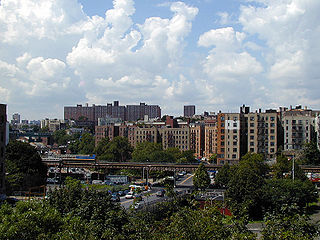
Morris Heights is a residential neighborhood located in the West Bronx. Its boundaries, starting from the north and moving clockwise are: West Burnside Avenue to the north, Jerome Avenue to the east, the Cross-Bronx Expressway to the south, and the Harlem River to the west. University Avenue is the primary thoroughfare through Morris Heights.
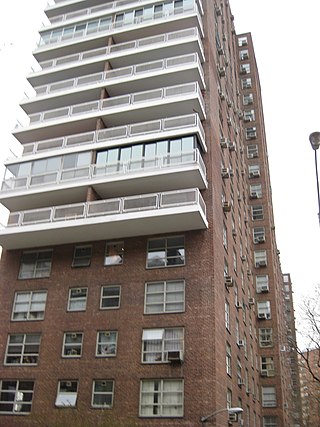
Morningside Gardens is a private housing cooperative operated by Morningside Heights Housing Corporation (MHHC) in Morningside Heights, Manhattan, New York City. It is composed of a parking garage and six apartment buildings of 21 stories each, for a total of about 980 apartments. MHHC rents space to the Children's Learning Center preschool and the Morningside Retirement and Health Service. The complex has many amenities for its cooperators including a playground, a fitness center, storage units, indoor play spaces for children and young adults, bike rooms, and a workshop including ceramics and woodworking.

The Robert Fulton Houses is a housing project located in the Chelsea neighborhood of Manhattan in New York City, owned and operated by the New York City Housing Authority (NYCHA). The 6.27-acre (2.54 ha) site is located between West 16th and 19th Streets and bounded by Ninth and Tenth Avenues. The project consists of 945 apartments in eleven buildings; three of the developments are 25 stories, while the others are 6 stories high.

The Lester Patterson Houses or Patterson Houses is a public housing development in the Mott Haven neighborhood of the Bronx, New York City. It was named after Bronx assemblyman and judge Lester W. Patterson. It is one of the largest New York City Housing Authority (NYCHA) complexes in the city with fifteen buildings 6 and 13-stories tall and 1,790 apartments. It spans an area of 17.18 acres (6.95 ha), which is located between East 138th and 145th Street and covers two main avenues, Third Avenue and Morris Avenue.

St. Nicholas Houses or "Saint Nick," is a public housing project in Central Harlem, in the borough of Manhattan, New York City and are managed by the New York City Housing Authority (NYCHA). The project is located between Adam Clayton Powell Jr. Boulevard and Frederick Douglass Boulevard, spanning a superblock from 127th Street to 131st Street. The project consists of thirteen 14-story buildings containing 1,523 apartment units.
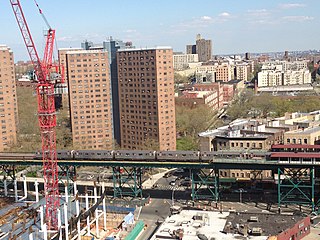
Manhattanville Houses is a public housing project in the Manhattanville section of West Harlem, in the borough of Manhattan, New York City. The project is located between Broadway and Amsterdam Avenue, spanning a superblock from 129th Street to 133rd Street and is managed by the New York City Housing Authority. The project consists of six 20-story buildings containing 1,272 apartment units.

The John Haynes Holmes Towers is a public housing project for low income residents of the Yorkville section of the Upper East Side located just south of the neighborhood's northern limit at 96th Street, in New York City, New York, United States. The neighboring Isaacs Houses and the Holmes Towers border East Harlem, which has the second highest concentration of public housing in the United States. The two public housing buildings, designed by Architects Eggers and Higgins, were completed in 1969, are 25 stories tall and contain 537 apartments. The project is located between 92nd and 93rd Streets from 1st Avenue to York Avenue and the FDR Drive.
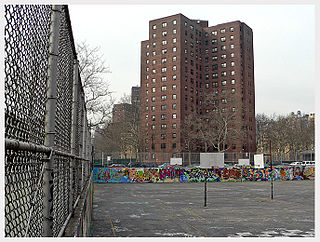
Carver Houses, or George Washington Carver Houses, is a public housing development built and maintained by the New York City Housing Authority (NYCHA) in Spanish Harlem, a neighborhood of Manhattan.

The Elliott-Chelsea Houses is a combined housing project of the New York City Housing Authority (NYCHA), located between West 25th and 27th Streets and Ninth and Tenth Avenues in the Chelsea neighborhood of Manhattan, New York City. It consists of two contiguous projects which were originally separate but have been combined for administrative purposes: the John Lovejoy Elliott Houses, named after the founder of the Hudson Guild, has four 11- and 12-story buildings which accommodate over 1400 residents in 589 apartments. The Chelsea Houses has over 1,000 residents in 426 apartments within two 21-story buildings.

The Farragut Houses is a public housing project located in the downtown neighborhood of northwestern Brooklyn, New York City, bordering the Brooklyn Navy Yard. Farragut Houses is a property of New York City Housing Authority (NYCHA). The houses contain 3,272 residents who reside in ten buildings that are each 13 to 14 stories high.

The Amsterdam Houses is a housing project in New York City that was established in the borough of Manhattan in 1948. The project consists of 13 buildings with over 1,000 apartment units. It covers a 9-acre expanse of the Upper West Side, and is bordered by West 61st and West 64th Streets, from Amsterdam Avenue to West End Avenue, with a 175-apartment addition that was completed in 1974 on West 65th Street between Amsterdam Avenue and West End Avenue. It is owned and managed by New York City Housing Authority (NYCHA).
The Forest Houses are a housing project in Morrisania, Bronx. The project consists of fifteen buildings, 9, 10 and 14-stories tall with 1,350 apartment units. It covers a 17.72-acre expanse, and is bordered by East 163rd and East 166th Streets, and Trinity and Tinton Avenues. It is owned and managed by New York City Housing Authority (NYCHA).

The Red Hook Houses are two connected public housing complexes located in Red Hook, Brooklyn, New York City. Managed by the New York City Housing Authority (NYCHA), they comprise the largest housing development in Brooklyn.
Kingsborough Houses-Kingsborough Extension, also known as Kingsborough Houses, is a 15.97-acre housing project in the Crown Heights neighborhood of Brooklyn in New York City. It is bordered by Ralph and Rochester Avenues, and Pacific and Bergen Streets. The project consists of 16, six-story buildings with 1,148 apartment units. It is owned and managed by New York City Housing Authority.
The Louis Heaton Pink Houses or Pink Houses are a housing project in New York City that were established in the East New York neighborhood in Brooklyn in 1959. It consists of 22 eight-storey buildings with 1,500 apartment units over a 31.1-acre expanse, bordered by Crescent Street, Linden Boulevard, Elderts Lane and Stanley Avenue. It is owned and managed by New York City Housing Authority (NYCHA).
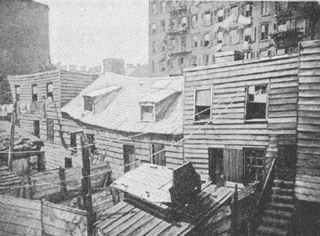
Slum clearance in the United States has been used as an urban renewal strategy to regenerate derelict or run-down districts, often to be replaced with alternative developments or new housing. Early calls were made during the 19th century, although mass slum clearance did not occur until after World War II with the introduction of the Housing Act of 1949 which offered federal subsidies towards redevelopments. The scheme ended in 1974 having driven over 2,000 projects with costs in excess of $50 billion.


















